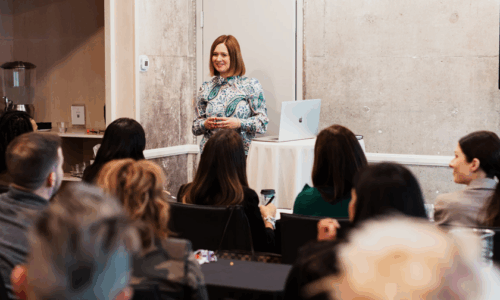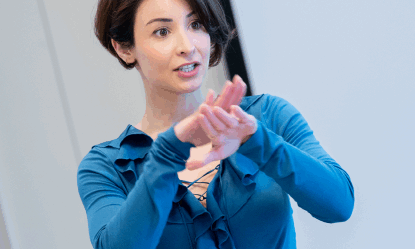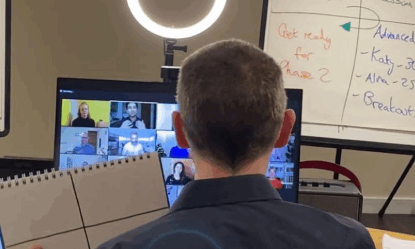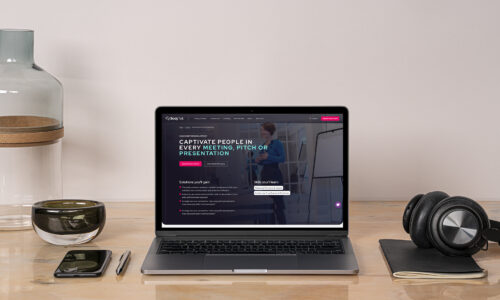The Missing Link: Make Your Presentations Clearer with Simple Linking Phrases
Have you ever sat through a presentation where the speaker seemed to rush from one idea to the next, leaving you a little bit lost? Maybe you’ve heard yourself say things like “Where is this going?” or “Why is this even relevant?”. The speaker may have had great content and plenty of energy, but somehow their message felt too hard to follow. And when you’re left to join the ideas together yourself, it’s difficult for key points to stick.
This happens much more often than people realise. It’s rarely down to a lack of knowledge or expertise, but more often the fact that the presentation is missing clear linking phrases. Adding in the right linking phrases to your presentations can help you sound more confident, make your message clearer and keep your audience engaged right through to the end.
In this article, we’ll look at some simple linking phrases you can use to add to your vocabulary and show how small changes in language and preparation can make a big difference to how your message lands.
What are Linking Phrases?
Linking phrases are words or expressions that help you to connect your ideas, explain your points and guide your audience through your message. Speakers use linking phrases strategically in their presentations to make their arguments stronger and their content easier to follow.
Why Linking Phrases Matter
When you present, you are taking your audience on a journey through your content. Your audience does not know your ideas like you do. They cannot read your mind or access information you don’t share with them. They need you to guide them through what you’re sharing and to help them understand what is important.
Linking phrases are like signposts through your content. They tell your audience where you are going next, explain why a point matters and show how one idea connects to the next.
Without them, your presentation can feel like a list of random facts, but when you use them, your presentation becomes a clear story.
Examples of Simple Linking Phrases
So what kinds of linking phrases actually help in a presentation? The most effective types of linking phrases help to:
- explain or clarify a point;
- show why something matters;
- move on smoothly to the next idea;
- give examples, or;
- summarise or close a section
Typical linking phrases may sound something like:
“And what that means is…” (Explaining)
This phrase can help you explain your point in really simple terms. After giving a fact or a figure, use this phrase to spell out why it matters.
e.g. “This new software will reduce processing time by 40%. And what that means is that we can serve customers much faster.”
“To put that another way…” (Clarifying)
This linking phrase is useful when you want to make sure your audience really understands what you are saying. It lets you restate your point in simpler or clearer terms.
e.g. “We’ve seen a drop in costs of around 15%. To put that another way, we’re saving roughly £50,000 a year.”
“The reason that’s important is…” (Showing why something matters)
Sometimes people hear information but do not know why it matters. This phrase makes the link for them.
e.g. “We’ve chosen to delay the project by a month. The reason that’s important is it gives us time to fix some key issues before launch.”
“Which brings me to…” (Moving on to the next point)
This helps you move from one point to the next in a way that feels natural. It also gives your audience a clear sense of structure.
e.g. “We’ve improved customer service response times by 30%. Which brings me to our next goal, boosting customer satisfaction scores.”
“Here’s what that looks like in practice” (Giving examples)
This is a nice alternative to a ‘for example’ statement to help your audience visualise your points.
e.g. “We are aiming to boost our customer satisfaction scores over the busy summer period. Here’s what that looks like in practice…”
“What I want you to take away is…” (Summarizing)
Never underestimate the power of a recap! This phrase helps you wrap things up and remind your audience of your key points. It also has the added bonus of being an attention-grabber! We naturally sit up and listen when we think that presentations are drawing to a close, so letting your audience know you’re nearly finished is a great point at which you can reiterate your key takeaways.
e.g. “So, what I want you to take away is that we’re launching three new products in spring 2027, and we’re confident that that’s going to boost sales by an extra 20%.”
How to use Linking Phrases Without Sounding Like A Robot
Linking phrases are really useful to act as bridges between parts of your presentation, but the danger of scripting too much is that you could end up sounding like a robot! The key to using these phrases well is to practise enough so that they become part of your natural speaking style.
To help you do this, here are a few hints:
- Practise using them out loud
The more you say them, the more natural they will feel when you are speaking in front of people. - Use a variety of phrases
You do not have to use the same one every time. Have a few that you like and swap them around depending on what feels right in the moment. - Watch good speakers
Listen carefully to speakers you admire. Chances are, they are using linking phrases throughout their talks, often without you even noticing. (And there’s nothing wrong with ‘borrowing’ good phrases from others, either!) - Keep it conversational
Imagine you are explaining your point to a friend. You will naturally use linking phrases in normal conversation, and that is the style you want in your presentation.
Linking Phrases Build Confidence
One of the great benefits of using linking phrases is how much they help your confidence. When you know how to connect your points clearly, you feel more in control of what you are saying. You are less likely to lose your place or end up rambling.
If you do lose your train of thought, a simple linking phrase like “Which brings me to…” or “Let me just recap…” can help you get back on track without it showing.
Your Audience Will Thank You
Good communication is all about making life easy for your audience. You want them to follow your message without having to work too hard. You want them to stay with you from start to finish and leave with a clear understanding of what you meant.
When you use linking phrases, you are showing respect for your audience. You are guiding them clearly, helping them stay on the journey with you and making it much more likely they will remember your key points.
Start now!
So the next time you prepare for a presentation, think about how you will link your points together. Make a note of a few linking phrases you plan to use and practise them out loud to see how they sound in your voice. The more you start to use them, the better you’ll become at sharing information and ideas.
And don’t forget – our team of experienced trainers are here at Body Talk to support you in finding your own voice, style and confidence when it comes to giving presentations. Get in touch with our team today to have a chat about how we can help.

















